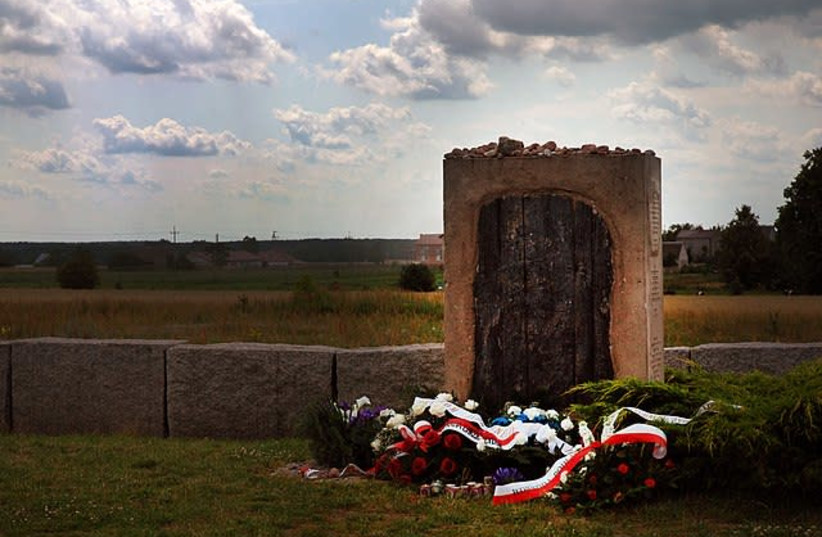There are very few books that influence the rewriting of history, but this book should be one of them. It is the history of the fate of the Jewish communities in 15 towns and villages in eastern Poland in the Bialystok region, in which the Jews were murdered beginning in the summer of 1941 not by the Nazis but by their Polish neighbors.
The communities that met this fate are: Radzilow, Wasosz, Jedwabne, Szczuczyn, Bzury, Skaje, Goniadz, Rajgrod, Jasionowka, Kolno, Suchowola, Bransk, Lipnik, Danowo, and Dziegiele.
The common denominator among them for more than half a century was the false narrative that their Jewish residents had been murdered by the Nazis, a “fact” inscribed on the various monuments to commemorate their memory. In 2001, however, Polish historian Jan Gross, who for many years had been teaching at Princeton, shocked Polish society by publishing Neighbors, a historically accurate narrative of the mass murder of almost all of the 1,600 Jews of Jedwabne, many of whom were burned alive by their neighbors in the barn of a Polish resident of the town.
Changing the narrative
Neighbors shocked Polish society and sparked intense internal controversy. Needless to say, it was totally rejected by ultranationalists and nationalists, and was considered an unprecedented attack on the accepted historical narrative of Poland during World War II. As the author explains in his concluding chapter, the Communists who ruled Poland in the aftermath of World War II completely denied the participation of Poles in Holocaust crimes. According to their version of the events, the Germans were the exclusive perpetrators of the crimes of the Holocaust, and many Poles were Righteous Among the Nations.
The facts revealed in Neighbors, however, cast serious doubt on that narrative, and created widespread public interest in the issue, which led to a forensic murder investigation of the events in Jedwabne by the Polish Institute of National Memory, which confirmed that the perpetrators were indeed ethnic Poles. In 2001, Polish President Aleksander Kwasniewski publicly apologized for the crime, as did President Bronislaw Komorowski in 2011.

Following the rise to power of the ultranationalist Law and Justice party, however, President Andrzej Duda publicly criticized Komorowski’s apology, leaving the crimes in Jedwabne an open wound in Polish society. This bitter ongoing controversy is what makes this book incredibly important because it conclusively proves that the murder of the Jews of Jedwabne was not an isolated incident, but rather a crime that was repeated by ethnic Poles in 14 other communities in the same geographic area during the same time period. Tryczyk’s research is impeccable and is primarily based on court documents from over 700 cases conducted in Poland under the decree of August 31, 1944, on the punishment of “Fascist-Nazi Criminals Guilty of Murder and Torture of Civilians and Prisoners and of the Traitors of the Polish Nation,” supplemented by additional relevant sources such as Jewish memoirs by survivors, the documentation of the proceedings of the Main Commission for the Investigation of Nazi Crimes in Poland, and many others.
Besides presenting much descriptive evidence on the crimes in each of the communities, and their incredible cruelty (Jews were burned alive, and murdered by iron-clad stakes, knives, axes, saws, pitchforks and hammers, but very rarely by firearms), Tryczyk attempts quite successfully to explain the reasons for the pogroms, and the four stages of the process that transformed the Jewish residents from neighbors to defenseless sub-humans.
The first stage was the intensive prewar antisemitic incitement against the Jews by the National Democrats political party and by many local Catholic priests. The second stage was the power vacuum left by the fall of the Polish state in 1939, and the subsequent flight of the Soviets in spring 1941, which was filled by the creation of a local Polish administration with its own militia, which took drastic measures against people accused of supporting the Soviets.
The third stage was characterized by attacks on wealthy Jews, plunder of their property, rape of Jewish women, and beatings and humiliations of Jews. The Nazis arrive in the fourth stage and give their approval for a pogrom. In some cases they leave the murders to the local perpetrators, in others they cooperate with the killers.
Given the controversial “history policy” of the Law and Justice party and their determination to hide the Holocaust crimes committed by ethnic Poles, as per the notorious law of 2018 that made attributing Holocaust crimes to the Polish state a punishable offense, and the attempt to punish outstanding Holocaust scholars Jan Grabowski and Barbara Engelking for revealing Polish participation in the Shoah, Tryczyk’s book has become even more important. It is not an easy book to read, but it is required reading for anyone interested in the Holocaust history of Polish Jewry. ■
Dr. Efraim Zuroff is the chief Nazi-hunter of the Simon Wiesenthal Center and director of the Center’s Israel Office and Eastern European Affairs.
The Towns of Death: Pogroms Against Jews By Their Neighbors
Miroslaw Tryczyk
Lanham, Maryland: Lexington Books, 2021.
$114.29; 426 pages
